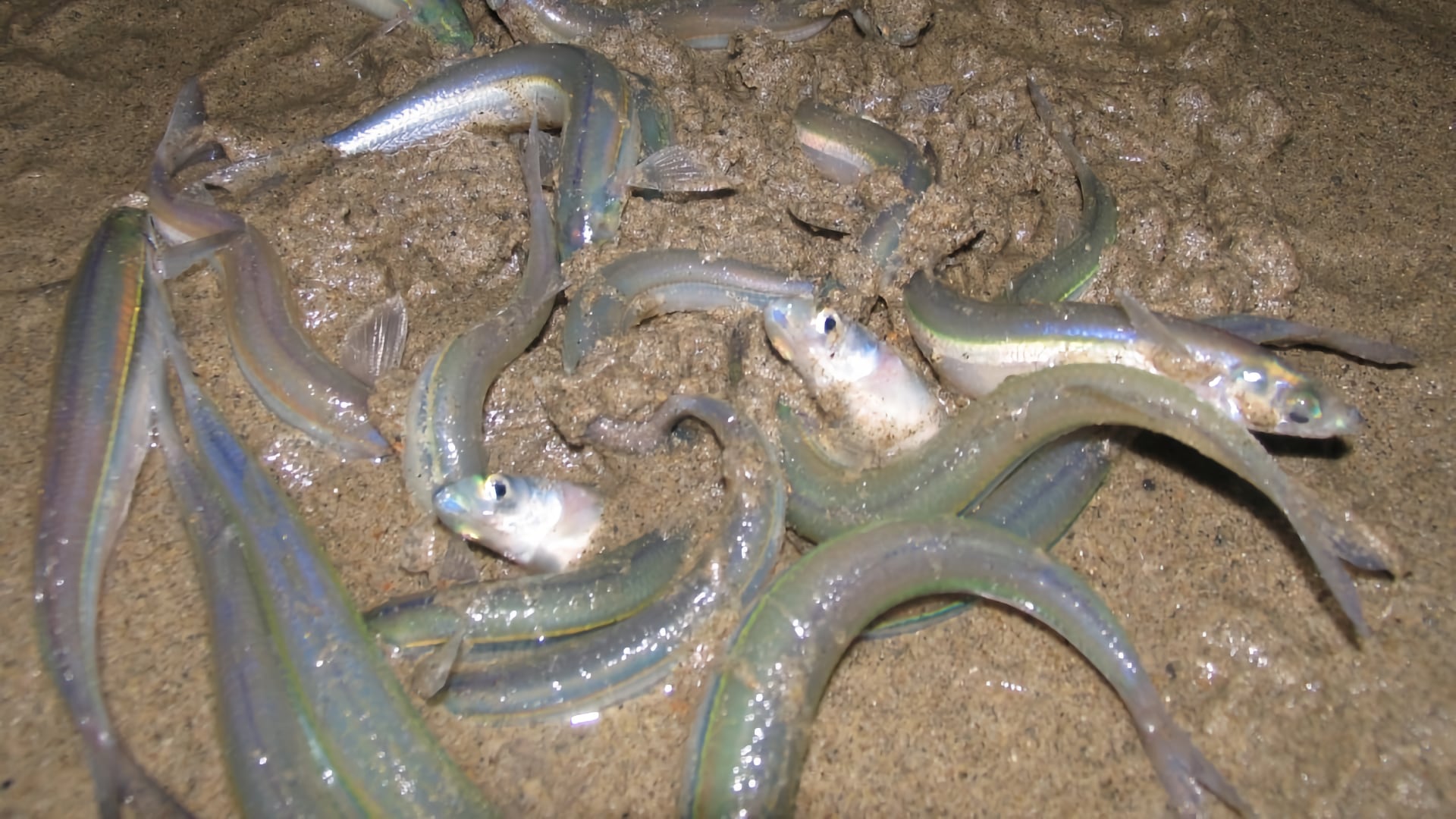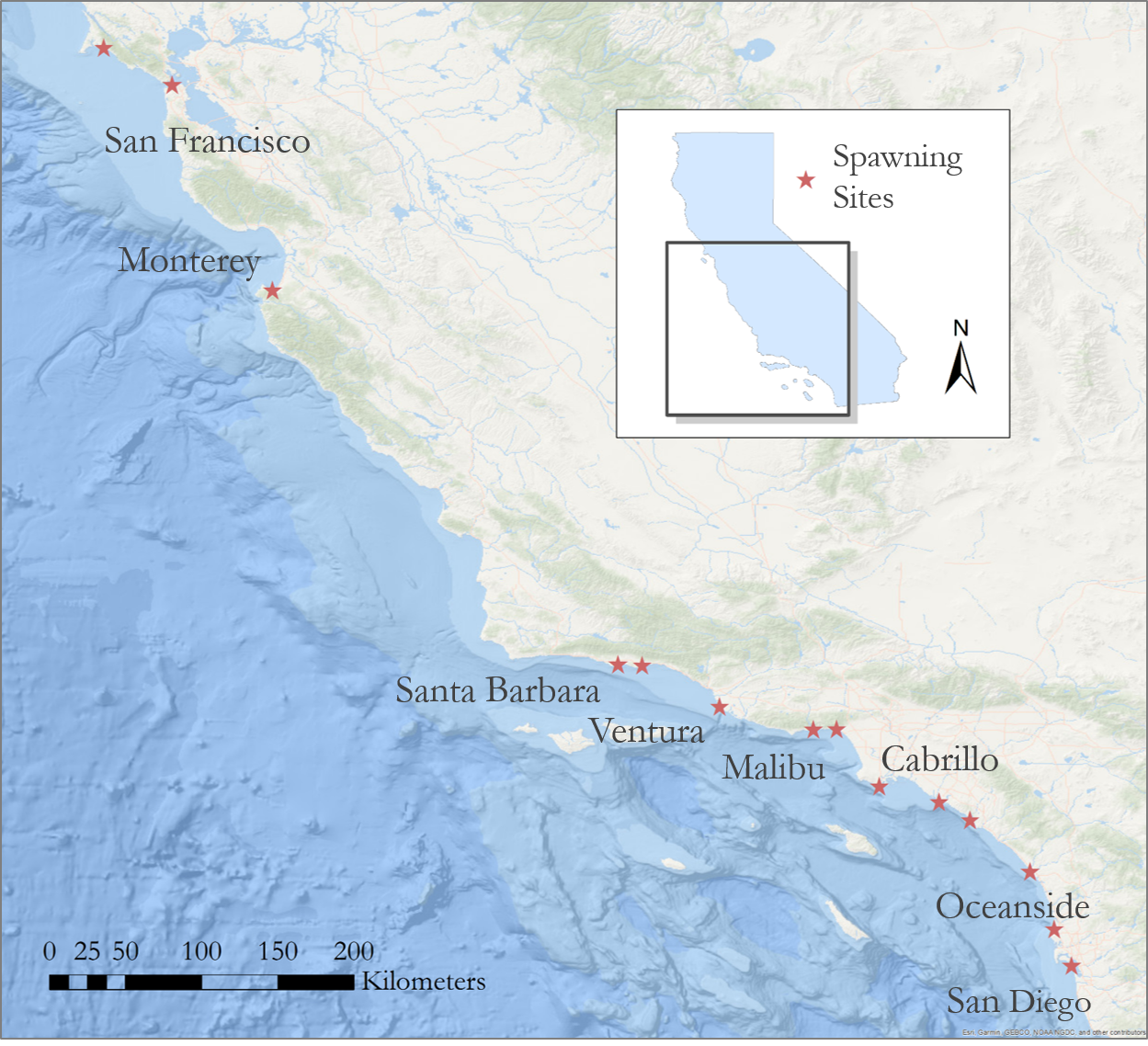DEVELOPing Connections
Predicting Grunion Migration Patterns and Spawning Areas in Response to Changes in California’s Oceans
Edited by Cecil Byles | Senior Fellow, DEVELOP National Program Office
March 5, 2021

Image of grunion spawning on the beach. Image credit: Julianne Steers, Grunion.org, with written permission

Composite of average June 2018 MODIS Aqua chlorophyll-a data and the California coastline from USGS Imagery Only. High chlorophyll-a values are indicated by red and low by dark blue. Image credit: NASA DEVELOP
The California grunion (Leuresthes tenuis) is a small silver fish that swims along the California coast and is known for its unique reproductive characteristics. These characteristics are showcased during an event called a “grunion run.” During a run, grunion swim from the ocean onto the beach in the middle of the night to spawn. In the morning, hundreds of tiny eggs line parts of California’s coastline and remain there until they are incubated and hatched. Dr. Karen Martin, Executive Director of the Grunion Greeters Project and a professor at Pepperdine University, researches the spawning habits of these fish. Dr. Martin said she is concerned about the “poleward habitat shift occurring [with grunion and other fish species] because the ocean is warming.” Dr. Martin highlighted that for grunion, “[Habitat suitability] is a little more complicated because they have to use the land as well as the ocean for a really important part of their life cycle. If you can imagine how temperature changes during the incubation of the eggs are going to affect them, that’s going to be a big concern.” She also stated that although “grunion are considered a managed species, their habitat range is changing … I just finished submitting a paper about their population over the years that we’ve been doing our public observations, and ... the data are pretty clear that the numbers of fish out there are dropping.” The grunion play a critical role in the marine food web, acting as a versatile food source for marine animals, seabirds, and other fishes. Grunion habitat shift and population decrease will negatively impact the entire food web, leading to decreased species abundance at higher trophic levels. To address her concerns over the habitat shift of these unique fish, Dr. Martin and the Grunion Greeters Project teamed up with NASA DEVELOP in summer 2017 for a two term project at the Jet Propulsion Laboratory (JPL) location in Pasadena, California.
Grunion runs attract people of all different backgrounds. People ranging from college students and young professionals to families and retirees collected the citizen science data that Dr. Martin manages. These runs are an engaging and fun way of educating the public about ocean-related issues, and Dr. Martin said she works with “partners in specific areas of the coast where the grunion would be likely to be seen,” such as “people … who work at aquariums, who are in environmental groups, or who are educators about the marine environment.” Additionally, she has a video online that tells citizen scientists how to look for the fish with an accompanying rubric to assess the runs for citizen science data collection. Furthermore, engaging the public with grunion runs has been beneficial for grunion research. As Dr. Martin mentioned, “it’s great to get that information because it is one of those things that you can’t get without citizen data. There is no other way to get these data.” The DEVELOP team was able to use grunion citizen science data to complement their remote sensing data analysis.

A map created by the team that shows certain spawning sites of grunion, including beaches included in analysis (Northern: San Francisco, Monterey; Central: Santa Barbra, Ventura; Southern: Malibu, Cabrillo, Orange County, Oceanside, San Diego). Image credit: NASA DEVELOP
The second term DEVELOP team worked with Dr. Martin, as well as Loni Adams from the California Department of Fish and Wildlife, during the summer of 2018 to expand upon the work completed by the first term of this project. Dr. Martin wanted a “different way of looking at how the distribution of the species is changing over time.” The team’s primary objectives were to create time series of satellite Earth observations and in situ data, compare time series at different beach locations to determine factors affecting grunion spawning patterns, and finally, to build an application to visualize satellite data and locate similar grunion runs based on oceanographic parameters.
Alexandra Jones, the DEVELOP project’s second term team lead, wrote that the team used the NASA Earth observation Aqua Moderate Resolution Imaging Spectroradiometer (MODIS) for consistent marine measurements of chlorophyll-a, an indicator of grunion habitat suitability. Jones also mentions they used NASA Multi-scale Ultra-high Resolution (MUR), a coupled data product that includes information from both satellite and in situ data sources with higher resolution than Aqua MODIS alone. By using these products and a few other datasets, the team was able to provide a comprehensive dataset with 15-day and monthly averages of ocean-related and other parameters that may affect grunion runs. Additionally, the team created a tool called Finding Suitable Spawning Habitats (FiSSH), a user-friendly application that can be used to see what specific parameters, such as ocean conditions, have had the most successful grunion runs. The FiSSH tool uses in situ data collected from citizen scientists and remotely sensed data. According to Jones, ocean temperature and chlorophyll-a levels are the parameters most correlated with grunion runs. She said the team found that “larger grunion runs are most often recorded in colder temperatures and high chlorophyll-a concentrations.” The DEVELOP team believed that California's long-term temperature increases in the south are driving the grunion northward.
The NASA DEVELOP JPL teams provided Dr. Martin data that will supplement her grunion work. Before working with DEVELOP, Dr. Martin said her work solely used data collected by “observers on the ground directly on the beaches.” The use of NASA Earth observations allows for a more comprehensive and larger-scale study on grunion spawning habits. Dr. Martin had not considered using remotely sensed data because she “did not have the technology to understand and to access the data ... it would be beyond [her] skill set.” Furthermore, she said that although some other organizations are trying to do similar work, “they don’t have the ability to synthesize the data and do the year-by-year analysis and [detailed] calculations that the NASA JPL people have, so it wouldn’t be possible to do at the same level.”
By studying migration patterns of grunion, tracking grunion spawning locations, and sharing this information broadly, grunion runs will be better protected and assist with grunion conservation. The work has already been shared with a group of people in the Beach Ecology Coalition. Dr. Martin is the chairman of this coalition, and she says its members include “beach managers, resource managers, people from California Coastal Commission, California State Parks, different cities along the coast of some beaches, lifeguards, environmental organizations – just a lot of people.” Although the California grunion is experiencing habitat shift and population decrease, if citizen, non-profit, and government scientists continue to work together, the unique grunion run may not be lost to the past.